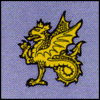Normandy 1944 - Hill 112

Click on map for larger image
The capture of Caen and Carpiquet at the same time was followed immediately by renewed attacks west of the city in order to capture the high ground between the Odon and the Orne, to encircle Caen from the south, and above all to continue to engage the main German force so it could not block an American breakout to the south. This time the attack was on a broader front with no fewer than six divisions: the 49th and 50th attacked south to Hottot, the 59th attacked south to Noyers, the 15th Scottish was to attack Evrecy, an objective of EPSOM, followed by the 53rd, and in the first attack the 43rd Division was to capture Hill 112 and Maltot on 10 July.
The 43rd Division already held a bridgehead across the Odon, which it had taken over from the 15th Scottish and the 11th Armoured Divisions when Epsom was terminated on 30 June. Since then it had held the panzer divisions that surrounded it on three sides, though the bridgehead was less than a mile wide, consisting of little more than the banks of the Odon and including Death Valley, so called because of the casualties from mortar bombs that burst in the narrow gorge of the river with its steep slate walls.
Hill 112 was an unimpressive stretch of country covered with wheat two or three feet high, and with a few wooded copses and several villages on its slopes. From this elevation the entire valleys of the Odon and Orne could be seen, and the Germans said, "He who controls Hill 112 controls Normandy." Certainly they clung to it desperately, and when they were driven off counter-attacked at once to regain possession. Between 29 June, when the 9th and 10th SS Panzer Divisions regained the hill, and 23 July, when they were driven from Maltot, the area around Hill 112 changed hands many times and thousands of Allied and German troops were killed or wounded on its bloody slopes. The 43rd Division alone lost more than 2,000 men in the first 36 hours of operation JUPITER to regain Hill 112. It was reported that the Odon River was dammed with corpses.
The attack began before dawn on 10 July with an impressive artillery barrage. By 0630 hours 129 Brigade - 4 and 5 Wilts. and 4 Som. LI - had advanced through the waist-high wheat sprinkled with poppies. They reached their objectives at the crest of the hill, although for several hours fierce close-quarter battles continued in the wheat where SS troops manned concealed machine-gun nests and refused to surrender even when wounded.
The task of 130 Brigade was to capture the villages of Eterville and Maltot, after which 214 Brigade was to exploit with an armoured brigade to the Orne. From a firm base provided by 5 Dorset, 4 Dorset launched a successful attack on Eterville, and at 0815 hours 7 R. Hamps. attacked Maltot, initiating what has been called "a battle of shattering intensity even by the standard of Normandy." SS panzer troops supported by dug-in and concealed Tiger tanks held an almost impregnable position, and even when the R. Hamps. were reinforced by 4 Dorset no progress could be made. Among the many casualties were five company commanders. From Eterville 5 Dorset and 7 SOM. LI held off savage counter-attacks, as did 5 Wilts. and 4 Som. LI during the day. By 1500 hours it was clear that a fresh attack on Hill 112 was needed, but of the 214th, the reserve brigade, two battalions had already been committed, leaving only 5 DCLI. The CO was 26-year-old Lieutenant-Colonel James, who had been in command only 14 days, since the former CO had been killed in the first attack at Mouen on 27 June. With 4 Som. LI as a firm base 5 DCLI launched an attack at 2230 hours with two companies up. The crest of the hill was reached and the battalion consolidated in a wood, which was later called Cornwall Wood, in time to meet savage counter-attacks from the 9th SS Panzer Division. In fighting that continued all night, 10 counter-attacks were beaten off, but when LieutenantColonel James was killed and most of the officers and NCO's killed or wounded, the remnants of the battalion withdrew. The CO of 4 Som. LI formed the survivors into two companies and sent them back to the wood for what has been called "the death struggle of 5 DCLI," The final overwhelming attack left about 75 survivors, approximately 10 percent of the original strength of the battalion.
After the battle, all battalions of the 43rd Division required reinforcements, which, in effect, produced new battalions. Within two weeks 5 DCLI was back at full strength and in action on Hill 112, and 4 Som. LI required reinforcements of 19 officers and 479 other ranks. The enemy suffered equally. The next year when there was an opportunity to compare notes with the 9th SS Panzer Division, it was revealed that in the battle for Hill 112 casualties reduced their strength to five or six per company. It is appropriate that the 43rd Division's memorial is at Hill 112, the object of so much bloodshed in the Normandy campaign. On 29 July when Maltot was captured at last by 4 and 5 Wilts., the dead of the Dorset and R. Hamps. who had fallen on 10 July still lay in heaps around partly dug slit trenches and in streets and fields.
Extracted from 'Code Word CANLOAN' by Wilfred I. Smith.

